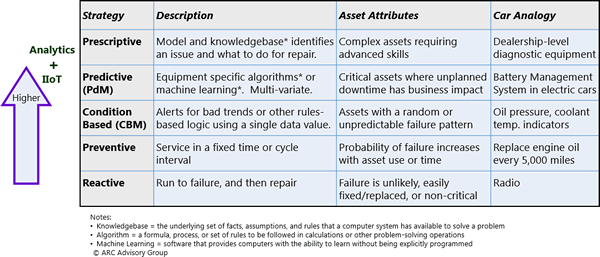Asset Performance Management (APM) 2.0 Maturity Model Advances with Industrial IoT
Industrial IoT (IIoT) combined with analytics enable improved maintenance strategies with business benefits that go beyond simple cost savings. With the emergence of IIoT, collecting data from equipment is moving from paper-based, manual inspections to automated systems.  This improves both data quality and quantity. IIoT-enabled remote asset monitoring also dramatically expands the number and variety of parameters that can be monitored cost effectively. Combined with today’s more advanced analytics, these data enable industrial organizations to implement new, more effective maintenance strategies. Progress further along on the maturity continuum from reactive, to preventive, to condition-based, to predictive, and – ultimately – to prescriptive maintenance.
This improves both data quality and quantity. IIoT-enabled remote asset monitoring also dramatically expands the number and variety of parameters that can be monitored cost effectively. Combined with today’s more advanced analytics, these data enable industrial organizations to implement new, more effective maintenance strategies. Progress further along on the maturity continuum from reactive, to preventive, to condition-based, to predictive, and – ultimately – to prescriptive maintenance.
With higher maintenance maturity, comes broader business benefits that go beyond reducing maintenance costs. These include improved on-time shipments, revenue, customer satisfaction, quality/yield, safety, and work-in-process (WIP) inventory. These benefits align with executive metrics; increasing the likelihood of obtaining both approval for projects and the resources needed for project success.
Asset Performance Management (APM) 2.0 Maturity Levels
For maintenance-related activities, IIoT brings a need to revisit the higher levels of maintenance maturity and associated definitions. A review of various maturity models among suppliers and users uncovered many versions and inconsistencies. Also, we do not have an industry standard to build upon. This lack of clarity makes it difficult to compare solutions, leading to confusion among potential users and delaying the application of solutions.
We now classify maintenance maturity into five types or levels: reactive, preventive, condition-based, predictive, and prescriptive. This APM 2.0 Maturity Model provides:
- A model to benchmark your maturity, and a clear understanding for how to improve
- Well defined and standardized terms allow solutions to be compared more easily
- Stakeholders in operations and maintenance gain a better understanding of where to apply IIoT
Industrial IoT allows organizations to move from manual inspections to automated systems to collect data. This vastly improves data quantity and quality, enabling improvements in maintenance strategies. The APM 2.0 Maturity Model helps you answer this question: “How can I best leverage IIoT to improve my organization’s operating performance?”
